Battle of Flodden
[7] However, relations were soon soured by repeated cross-border raids, rivalry at sea leading to the death of the Scottish privateer Andrew Barton and the capture of his ships in 1511,[8] and increasingly bellicose rhetoric by King Henry VIII of England in claiming to be the overlord of Scotland.He declared:And now, for a conclusion, recommend me to your master and tell him if he be so hardy to invade my realm or cause to enter one foot of my ground I shall make him as weary of his part as ever was man that began any such business.[13] Using the pretext of revenge for the murder of Robert Kerr, a Warden of the Scottish East March who had been killed by John "The Bastard" Heron in 1508, James invaded England with an army of about 30,000 men.A year earlier, Thomas Howard, Earl of Surrey, had been appointed Lieutenant-General of the army of the north and was issued with banners of the Cross of St George and the Red Dragon of Wales.[15] On 5 August, a force estimated at up to 7,000 Scottish border reivers commanded by Lord Home, crossed into Northumberland and began to pillage farms and villages, taking anything of value before burning the houses.On 13 August, they prepared an ambush for the Scots as they returned north laden with the spoils of their looting, by hiding in the broom bushes that grew shoulder-high on Milfield Plain.[18] On 18 August, five cannons brought down from Edinburgh Castle to the Netherbow Port at St Mary's Wynd for the invasion set off towards England dragged by borrowed oxen.[27] By 29 August after a siege of six days, Bishop Thomas Ruthall's Norham Castle was taken and partly demolished after the Scottish heavy artillery had breached the recently refurbished outer walls.[29] A later Scottish chronicle writer, Robert Lindsay of Pitscottie, tells the story that James wasted valuable time at Ford enjoying the company of Elizabeth, Lady Heron and her daughter.[37] The Earl of Surrey, writing at Wooler Haugh on Wednesday 7 September, compared this position to a fortress in a challenge sent to James IV by his herald, Thomas Hawley, the Rouge Croix Pursuivant.[38] James had no intention of leaving his carefully prepared position, perhaps recalling the fate of the Ill Raid on the same plain; he replied to Surrey that it was "not fitting for an Earl to seek to command a King".[40] Waiting for James to make a move was not an option because his 20,000-26,000 strong army desperately needed resupply, the convoy of wagons bringing food and beer for the troops from Newcastle having been ambushed and looted by local Englishmen.[41][42] During a council of war on Wednesday evening, an ingenious alternative plan was devised, advised by "the Bastard" Heron, who had intimate local knowledge and had recently arrived at the English camp.[44] At 5 am on the morning of Friday, 9 September, after a damp night on short rations and having to drink water from streams because the beer had run out, Surrey's men set off westwards to complete their manoeuvre.James quickly saw the threat and ordered his army to break camp and move to Branxton Hill, a commanding position which would deny the feature to the English and still give his pike formations the advantage of a downhill attack if the opportunity arose.[48] The Scottish infantry had been equipped with 18 feet (5.5 m) long pikes by their French allies; a new weapon which had proved devastating in continental Europe, but required training, discipline and suitable terrain to use effectively.Contemporary accounts put this down to the difficulty for the Scots of shooting downhill, but another factor must have been that their guns had been poorly sited instead of being carefully emplaced, which was usually required for such heavy weapons, further slowing their ponderous rate of fire.The apparent silence of the Scottish artillery allowed the light English guns to turn a rapid fire on the massed ranks of infantry, although the effectiveness of this bombardment is difficult to assess.At the foot of Branxton Hill, they encountered an unforeseen obstacle, an area of marshy ground, identified by modern hydrologists as a groundwater seepage zone, made worse by days of heavy rain.The letter also mentions that the Scots placed their officers in the front line in medieval style, where they were vulnerable, contrasting this loss of the nobility with the English great men who took their stand with the reserves and at the rear.Howard was moved to dismount and do this by taunts of cowardice sent by James IV's heralds, apparently based on his role at sea and the death two years earlier of the Scottish naval officer Sir Andrew Barton.[75] Although the pike had become a Swiss weapon of choice and represented modern warfare, the hilly terrain of Northumberland, the nature of the combat, and the slippery footing did not allow it to be employed to the best effect.Two years later Francis I of France defeated the Swiss pikemen at the Battle of Marignano, using a combination of heavy cavalry and artillery, ushering in a new era in the history of war.She sent news of the victory to Henry VIII at Tournai with Hawley, and then sent John Glyn on 16 September with James's coat (and iron gauntlets) and a detailed account of the battle written by Lord Howard."[97] In addition to these relics, the gold crucifix worn by James IV on the field of battle, set with three balas rubies and three sapphires and containing a fragment of the True Cross, was listed in the jewel book inventory of Henry VIII in the chapel of the Tower of London.While he was praying in St Michael's Kirk at Linlithgow, a man strangely dressed in blue had approached his desk saying his mother had told him to say James should not go to war or take the advice of women.Lord Lindsay advised the King to withdraw, comparing their situation to an honest merchant playing dice with a trickster, and wagering a gold rose-noble against a bent halfpenny.A contemporary account produced in French for the Royal Postmaster of England, in the immediate aftermath of the battle, states that about 10,000 Scots were killed,[3] a claim repeated by Henry VIII on 16 September while he was still uncertain of the death of James IV.[114] The dead are remembered by the song (and pipe tune) "Flowers of the Forest": Contemporary English ballads also recalled the significance of the Scottish losses: A legend grew that while the artillery was being prepared in Edinburgh before the battle, a demon called Plotcock had read out the names of those who would be killed at the Mercat Cross on the Royal Mile.These contemporary sources include; the Articles of the Bataill bitwix the Kinge of Scottes and therle of Surrey in Brankstone Field said to be a field despatch; Brian Tuke's news-letter to Cardinal Bainbridge; an Italian poem, La Rotta de Scosesi in part based on Tuke's letters; a news-sheet printed in London, The Trewe Encountre; another lost news-sheet printed by Richard Pynson which was the source used in Edward Hall's Chronicle.
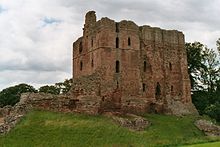
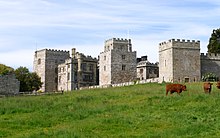

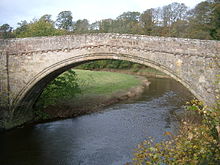


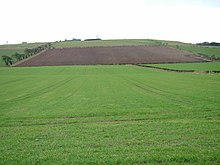
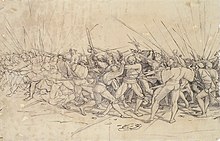
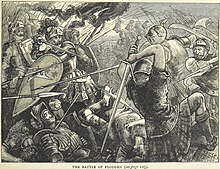


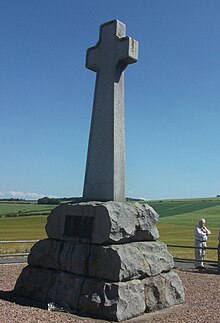

War of the League of CambraiBranxtonNorthumberlandEnglandKingdom of EnglandKingdom of ScotlandCatherine of AragonEarl of SurreyLord Thomas HowardLord Edmund HowardBaron DacreBaron MonteagleKing James IVLord HomeEarl of MontroseEarl of BothwellEarl of LennoxEarl of ArgyllCadoreAgnadelloVicenzaPolesellaMirandolaBresciaRavennaNavarreSaint-MathieuNovaraGuinegate/The SpursLa MottaMarignanoAnglo-Scottish WarsMelroseOtterburnFulhope LawNesbit MoorHomildon HillYeaveringBaugéCravantVerneuilOrléansHerringsMeung-sur-LoireBeaugencyPiperdeanRoxburghBerwickHornsholeHaddon RigSolway MossEdinburghAncrum MoorPinkieDrumlanrigHaddingtonRedeswireJames IVGreat BritainMiddle AgesBritish IslesBattle of Bosworth FieldTreaty of Perpetual PeaceprivateerAndrew BartonHenry VIII of EnglandJames IV, King of ScotsAuld AllianceLouis XIICatholic LeagueItalian WarsPope Leo XTreaty of MechlinexcommunicatedChristopher BainbridgeGreat MichaelJames Hamilton, 1st Earl of ArranFirth of ForthIsle of MayEnglish ChannelEmperor Maximiliansiege of ThérouanneLyon King of ArmsIslay HeraldLyon KingMargaretWardenMargaret of Austria, Duchess of SavoyThomas Howard, Earl of SurreyCross of St GeorgeRed Dragon of Walesborder reiversMilfield PlainEdinburgh CastleNetherbow Port at St Mary's Wyndculverins(mid-sized) culverins moyaneJohn DrummondSt MargaretThomas LovellMidland countieschivalryBurgh MuirDuns, Scottish BordersRiver TweedColdstreamfeudal obligationWark on Tweed CastleNorham CastleTwiselhaughThomas RuthallFord CastleRobert Lindsay of PitscottieEdward HallRouge CroixheraldsRaphael HolinshedBerwick-upon-TweedMaster of AngusGlenberviePontefractNewcastle on TyneThomas HowardLord High Admiral of EnglandDurham CathedralCuthbert